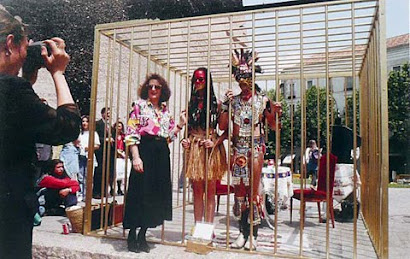“Appropriation is something I have used or worked with in my art since starting art school in 1987. At this time (and still now)
Time Between Spaces, Palais de Tokyo & Musée d’Art Moderne de la Ville de Paris, 2008

For ‘Time Between Spaces’, Jonathan Monk has distributed a group of nearly 40 objects throughout two rooms in the Palais de Tokyo and the mirroring Musée d’Art Moderne de la Ville de Paris. Across his broader oeuvre, Monk consistently recasts or extends conceptual art’s most emblematic strategies, and ‘Time Between Spaces’ is no exception. The exhibition’s altered bicycles, grandfather clocks, canvases, furniture, and walkie-talkies draw much of their meaning from external and ideas-based sources. Yet when it comes to the artist’s choice to work between the two exhibition spaces, his typical array of conceptual references don’t rally round. The significance of the paired venues is far from self-evident.
Though Monk understandably resists the language of site-specificity or institutional critique, he is unable to prevent the two museums’ environmental and institutional differences from becoming a preoccupying theme. His works just aren’t up to it. Do the spare displays really represent the sort of ‘ubiquity’ that would ‘allow us to thwart the linear progression of time’, as suggested by the exhibition text? The equation of duplication with ubiquity is less than convincing. Monk should either augment his conceptual grounding, or recourse to more formal visual persuasion. When he does, in Nothing Turning Around by Itself at the Palais and We Feel Lost Without You (both 2008) in the Musée, we finally understand his evocation of an exhibition ‘somewhere between the two exhibition areas’; the flashing reflections on this group of spinning mirrored disks are just unrecognizable enough to seem like portals to elsewhere. Here is a ‘third’ place that fulfills Monk’s goal to evoke ‘time between spaces’.
As it stands, rather than ‘undermining the museum authority vested in a work of art by taking away its sacred aura and inscribing it closer to the public’, as the accompanying text claims, ‘Time Between Spaces’ seems designed to inspire a certain anomie: that of the uninitiated museum-goer faced with objects that demand to be met half-way, in a space whose immediacy is at once preoccupying and insistently ignored by the powers that be – twice over. Sarah-Neel Smith

On these cups, produced by Mercer Union Artist Centre in Toronto, Monk has etched the time and place of Niagara Falls/August 1, 2015, but he doesn't make any kind of guarantee that he'll be there. This project is #56 in the "Meeting" series, but I can't find any information if any of the previous 55 meetings (for example, the October 18, 2008 meeting at the Eifel tower) have occurred.

Continuous Project Altered Daily marks the first comprehensive survey of British artist Jonathan Monk and offers an extensive overview of his exceptionally prolific artistic practice. Over 60 artworks made between 1993 and 2005 will be on display including painting, sculpture, installation, photography, film and video work.
Monks diverse practice brings together two seemingly disparate histories: that of his own, and that of conceptual art of the 1960s and 70s. Autobiographical details, personal anecdotes drawn from his UK upbringing, tender and idiosyncratic portraits of his family, his mother Rita, his father Owen, and older sister Vanessa, the pet dog even the Leicester City Football Club are referenced apparently incongruously alongside the strategies and language of conceptualism and the work of artists such as Sol LeWitt, John Baldessari, Ed Ruscha and Robert Barry. The key principles of conceptualism (the favouring of ideas over object-making, the dematerialisation of the art object, the production of work in series, in collaboration and often without a studio) are leveled and humanised by the quirky humour and down-to-earth sensibility of Monks working class family life. Beneath this playful, ironic take on art making, however, is a serious scrutiny of the very idea of art, its status, appearance and market value, as well as the myth of the artistic genius
The title of this exhibition is taken from an exhibition by US artist Robert Morris made in 1969 and describes the concept behind the display of works and to the way the presentation is constantly recycled and refreshed. Over a period of two months, the vast body of Monks work will be presented in sequence rather than in an edited selection within a single space and as a static display. A different show will, effectively, be curated every day and thus each visit will reveal a changed exhibition. The Lower Gallery of the ICA will act as an art warehouse and contain all of the works involved in the exhibition, whilst the Upper Gallery will display individual pieces drawn from the storage, and will change on a daily basis within a classic white cube space. Consequently Continuous Project Altered Daily will not only trace the development of Monks practice through carefully constructed sequences of his work, but also, because of its perpetually transforming nature, function as a challenge to the usually static dynamic of traditional art presentation.
from e-flux, 10/09/2005, http://www.e-flux.com/shows/view/2291

In my search I found the twitter page of "Monk and Kelly", a husband and wife Christian radio host duo currently based out of Atlanta. Jonathan Monk & Dianna Kelly have been married for 20 years and have been a fun, entertaining and family friendly morning radio team for 19 of them. Monk & Kelly blend their real life stories with listeners’ interactive calls, useful information, and tremendous celebrity and artist interviews. It’s the entire package for your morning show, topical, engaging conversation and top celebrities. They have two children, Austin, age 13, and Janina, age 12, and two adorable terriers. (from http://monkandkelly.com)


No comments:
Post a Comment